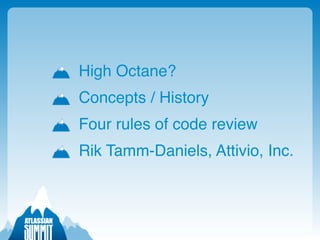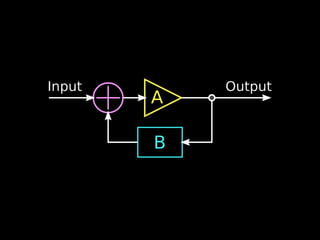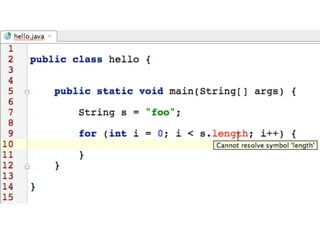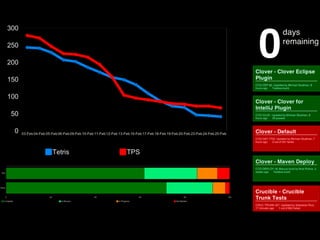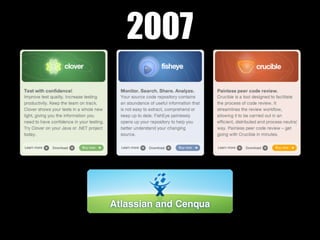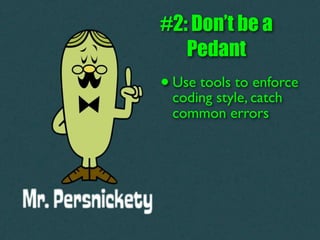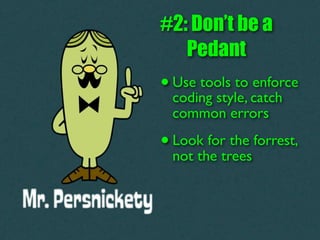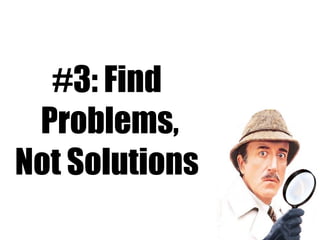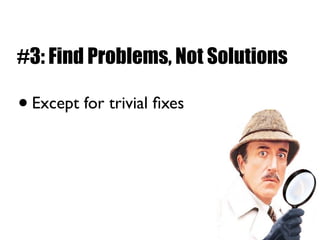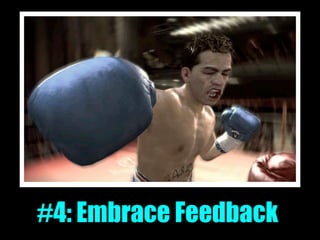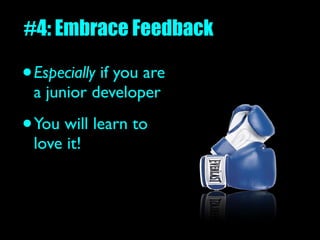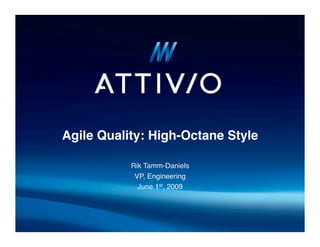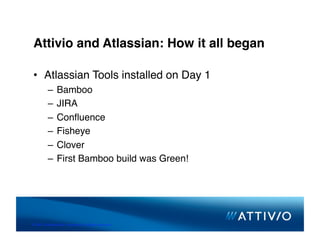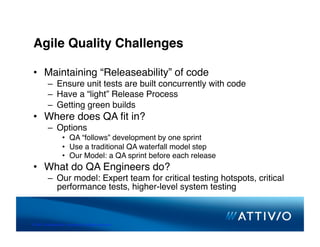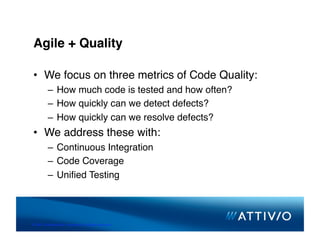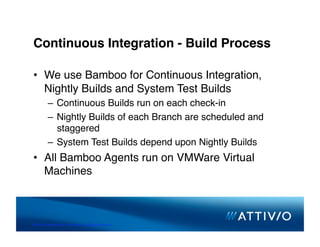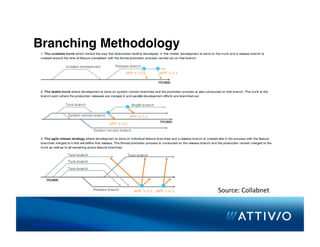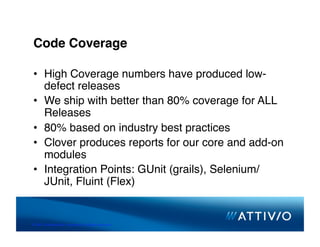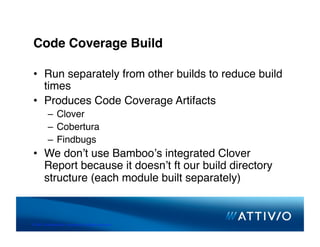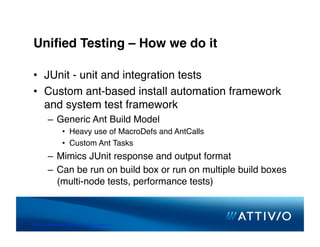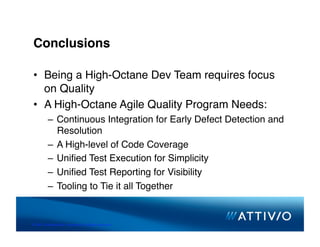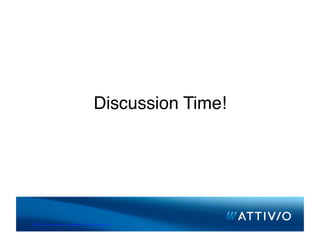High-Octane Dev Teams: Three Things You Can Do To Improve Code Quality
- 1. High Octane Dev Teams Brendan Humphreys
- 2. High Octane? Concepts / History Four rules of code review Rik Tamm-Daniels, Attivio, Inc.
- 3. High Octane?
- 10. Smarter Tools • Checkstyle, Lint, PMD • Findbugs • Clover
- 17. 1998
- 21. 2007
- 25. #1: Ego-Free Reviews • No personal Pronouns
- 26. #1: Ego-Free Reviews • No personal Pronouns • No point scoring
- 27. #1: Ego-Free Reviews • No personal Pronouns • No point scoring • Moderator to police
- 29. #2: Don’t be a Pedant
- 30. #2: Don’t be a Pedant • Use tools to catch coding style, enforce common errors
- 31. #2: Don’t be a Pedant • Use tools to catch coding style, enforce common errors • Look fortrees forrest, not the the
- 32. #3: Find Problems, Not Solutions
- 33. #3: Find Problems, Not Solutions
- 34. #3: Find Problems, Not Solutions • Except for trivial fixes
- 35. #3: Find Problems, Not Solutions •Except for trivial fixes • Pair program instead
- 37. #4: Embrace Feedback • Especially if you are a junior developer • You will learn to love it!
- 38. Agile Quality: High-Octane Style Rik Tamm-Daniels VP, Engineering June 1st, 2009
- 39. About Attivio • Located in Newton, MA • Founded August 2007 • 45+ Employees • What we do: Unified Information Access © 2007 Confiden,al & Proprietary. All Rights Reserved.
- 40. What are we building? • Attivioʼs Active Intelligence Engine – Unified Information Access Platform – Query Unstructured and Structured Information with the Precision of SQL and the Fuzziness of Search • Shipped Product (OEM and Direct) – Maintenance Release Window at the end of each sprint – Minor Release every 3-4 months – Major Releases Every 12-18 months • Product Specs: – 100% Java – 200 MB Install – 200K Lines of Code (8000+ automated tests) © 2007 Confiden,al & Proprietary. All Rights Reserved.
- 41. What makes Attivio High-Octane? • Our Team – 15 Engineers (10 very senior) – Expertise in Enterprise Search, Data Warehousing, ETL, Linguistics, Data Mining • Our Process – Agile Development • 4 week Sprints: 3 weeks of design/code/document/test and 1 week of “Reflection” – Agile QA © 2007 Confiden,al & Proprietary. All Rights Reserved.
- 42. Attivio and Atlassian: How it all began • Atlassian Tools installed on Day 1 – Bamboo – JIRA – Confluence – Fisheye – Clover – First Bamboo build was Green! © 2007 Confiden,al & Proprietary. All Rights Reserved.
- 43. Our Process • Evolutionary Process – Sprint-by-sprint incremental process changes • Reliance on Tools – Process Tools: JIRA, Confluence, Clover, Bamboo, Fisheye – Dev Tools: SVN, Ant, Eclipse, JMeter • Comprehensive Quality Strategy © 2007 Confiden,al & Proprietary. All Rights Reserved.
- 44. Agile Quality Challenges • Maintaining “Releaseability” of code – Ensure unit tests are built concurrently with code – Have a “light” Release Process – Getting green builds • Where does QA fit in? – Options • QA “follows” development by one sprint • Use a traditional QA waterfall model step • Our Model: a QA sprint before each release • What do QA Engineers do? – Our model: Expert team for critical testing hotspots, critical performance tests, higher-level system testing © 2007 Confiden,al & Proprietary. All Rights Reserved.
- 45. Agile + Quality • We focus on three metrics of Code Quality: – How much code is tested and how often? – How quickly can we detect defects? – How quickly can we resolve defects? • We address these with: – Continuous Integration – Code Coverage – Unified Testing © 2007 Confiden,al & Proprietary. All Rights Reserved.
- 46. Continuous Integration - Build Process • We use Bamboo for Continuous Integration, Nightly Builds and System Test Builds – Continuous Builds run on each check-in – Nightly Builds of each Branch are scheduled and staggered – System Test Builds depend upon Nightly Builds • All Bamboo Agents run on VMWare Virtual Machines © 2007 Confiden,al & Proprietary. All Rights Reserved.
- 47. Build Agent Configuration Build Agent Linux x64 VM Build Type Default Agent Linux x64 Linux x64 Linux x64 Linux x86 Windows Windows Solaris x64 VM VM VM VM x86 VM x64 VM VM Con,nuous Old Version QA Install/ Full Nightly Full Nightly Full Nightly Code Check Trunk Build Con,nuous System Tests Build Build Build Full Nightly Full Nightly Build Build © 2007 Confiden,al & Proprietary. All Rights Reserved.
- 48. Branching Methodology Source: Collabnet © 2007 Confiden,al & Proprietary. All Rights Reserved.
- 49. Branching Methodology • We use the Unstable Branching Strategy – Fits with the agile methodology better that the Agile Branching strategy • No need to deal with too many branches • Since our modules are already self contained we are continually integrating all modules right in trunk • Less merging more branching • Ready to release code at any time without merging or branching – In large part because of our test coverage – Having system, integration, smoke and performance testing as part of our daily activity © 2007 Confiden,al & Proprietary. All Rights Reserved.
- 50. Code Coverage • High Coverage numbers have produced low- defect releases • We ship with better than 80% coverage for ALL Releases • 80% based on industry best practices • Clover produces reports for our core and add-on modules • Integration Points: GUnit (grails), Selenium/ JUnit, Fluint (Flex) © 2007 Confiden,al & Proprietary. All Rights Reserved.
- 51. Code Coverage Build • Run separately from other builds to reduce build times • Produces Code Coverage Artifacts – Clover – Cobertura – Findbugs • We donʼt use Bambooʼs integrated Clover Report because it doesnʼt ft our build directory structure (each module built separately) © 2007 Confiden,al & Proprietary. All Rights Reserved.
- 52. Code Coverage Build Artifacts © 2007 Confiden,al & Proprietary. All Rights Reserved.
- 53. Unified Testing • Unified Testing Defined: – Common Infrastructure (Execution, Reporting) • Execution: Bamboo • Reporting: Clover/Bamboo – Single point of defect detection and investigation • Bamboo + JIRA and Fisheye Integration • Benefits – Fewer systems for QA to learn – Easier to maintain than traditional QA environments – Consistent format for defect reporting and notification – Unified view of system quality – Easier to identify testing gaps © 2007 Confiden,al & Proprietary. All Rights Reserved.
- 54. Unified Testing – How we do it • JUnit - unit and integration tests • Custom ant-based install automation framework and system test framework – Generic Ant Build Model • Heavy use of MacroDefs and AntCalls • Custom Ant Tasks – Mimics JUnit response and output format – Can be run on build box or run on multiple build boxes (multi-node tests, performance tests) © 2007 Confiden,al & Proprietary. All Rights Reserved.
- 55. Unified Testing - Reporting • The combination of Bamboo and Clover give us a complete view of product quality – High-level build status – Test Failure Reports – Build Logs – Build Artifacts (Clover, Findbugs) • JIRA and Fisheye integration allows us to quickly identify and resolve problems – JIRA tickets – Check-in Diffs © 2007 Confiden,al & Proprietary. All Rights Reserved.
- 57. Conclusions • Being a High-Octane Dev Team requires focus on Quality • A High-Octane Agile Quality Program Needs: – Continuous Integration for Early Defect Detection and Resolution – A High-level of Code Coverage – Unified Test Execution for Simplicity – Unified Test Reporting for Visibility – Tooling to Tie it all Together © 2007 Confiden,al & Proprietary. All Rights Reserved.


